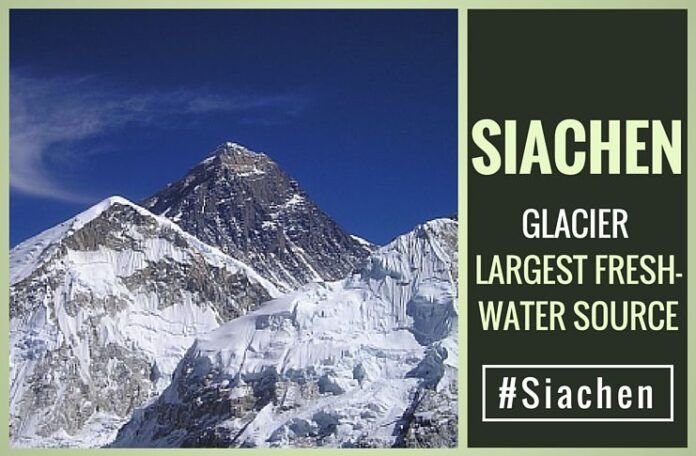
[dropcap color=”#008040″ boxed=”yes” boxed_radius=”8px” class=”” id=””]A[/dropcap]t the top of Siachen, the temperature that will drop to minus-fifty degrees Celsius. The planet’s greatest battleground, is actually a challenging terrain. It also holds the subcontinent’s biggest fresh-water supplies.
India and Pakistan, the two sparring nuclear nations, have stationed their troops in high number in an area that will be currently experiencing clear symptoms of an effect from climate change, increasing a water crisis’ looming larger.
The conflict between Pakistan and India, traditionally, continues to be overland, both claiming the Kashmir valley. Water problems are part of the image.
The Indus Water Treaty signed in 1960 by Jawaharlal Nehru and Ayub Khan had its premise in the fear that India could potentially create droughts and famines in Pakistan, especially at times of war, as the Indus, the river that brings life to most of Pakistan, flows out from India.
[dropcap color=”#008040″ boxed=”yes” boxed_radius=”8px” class=”” id=””]T[/dropcap]he melt water of Saichen glacier is the main source of the Nubra river, which drains into the Shyok river. The Shyok then joins the 3,000 km-long Indus river which flows through Pakistan. Both India and Pakistan had their claims on the glacier. In 1983, Pakistan decided to deploy troops on the glacier. India acted swiftly and launched Operation Meghdoot.
At present, India occupies most of the glacier, Pakistan being only on the western side of the Saltoro ridge. Both armies have been stationed here, losing more soldiers to climate than to bullets.
This year alone, India has lost 12 soldiers and one porter in Siachen.
In a reply in the Lok Sabha, Defence Minister Manohar Parrikar said India has lost 915 soldiers in Siachen in the last 33 years. The number on Pakistan’s side are similar.
[dropcap color=”#008040″ boxed=”yes” boxed_radius=”8px” class=”” id=””]W[/dropcap]hile neither India nor Pakistan have admitted to the water angle of the dispute, Pakistan did accuse India of threatening the ecology of the glacier with its troop presence. In 2013, a report of the Asian Development Bank declared Pakistan as one of the most “water-stressed” countries in the world.
In December that year, Sartaj Aziz, advisor to the Pakistan prime minister on foreign affairs, said Pakistan was facing a water shortage and Indian forces were damaging one of the largest sources of water to Pakistan on a regular basis.
He also accused Indian forces stationed in Siachen of posing a “serious threat” to Pakistan’s environment by damaging Siachen’s “virgin snow”.
India, with its strategic concerns, amplified after the 1999 Kargil conflict, has clearly stated that troops will not be withdrawn from the glacier.
[dropcap color=”#008040″ boxed=”yes” boxed_radius=”8px” class=”” id=””]P[/dropcap]arrikar, following the death of 10 soldiers in an avalanche in Siachen earlier this year, said that he regretted the loss of life but ruled out removal of troops, stating that occupancy of the area by rival troops will lead to bigger loss of lives.
Climatologists and scientists however paint a grim picture when they talk about the shrinking of the glacier and rising temperatures, which they say has also led to more avalanches that are killing soldiers.
As per research data, including that from the defence ministry’s Snow and Avalanche Studies Establishment, frequency of avalanches has gone up with both maximum and minimum temperatures rising. However, this, along with sudden steep falls, causes more cracks and avalanches.
According a report by the World Wildlife Fund on Climate Data and Modelling Analysis of Indus Region, rising temperatures in Siachen have lead to a greater rate of thinning of ice and glacial retreat.
The decay estimates calculated by remote sensing techniques show that Siachen Glacier has reduced by 5.9 km in longitudinal extent from 1989 to 2009. Thinning of ice mass is evaluated at 17 percent.
The guns have been silent on the world’s highest battlefield since 2003 but nature is pretty active, creating a long-term threat to livelihood and well being of people in the region.
(IANS)
- Elon Musk postpones India visit. Non-clarity in Tesla partner and Starlink license might be the reasons - April 20, 2024
- NIA confiscates Pak-harboured Khalistani terrorist Lakhbir Singh Rode’s key aide’s land in Moga - April 19, 2024
- Prime Minister Narendra Modi: A Gujju businessman who does not invest his precious time for a losing battle - April 13, 2024







